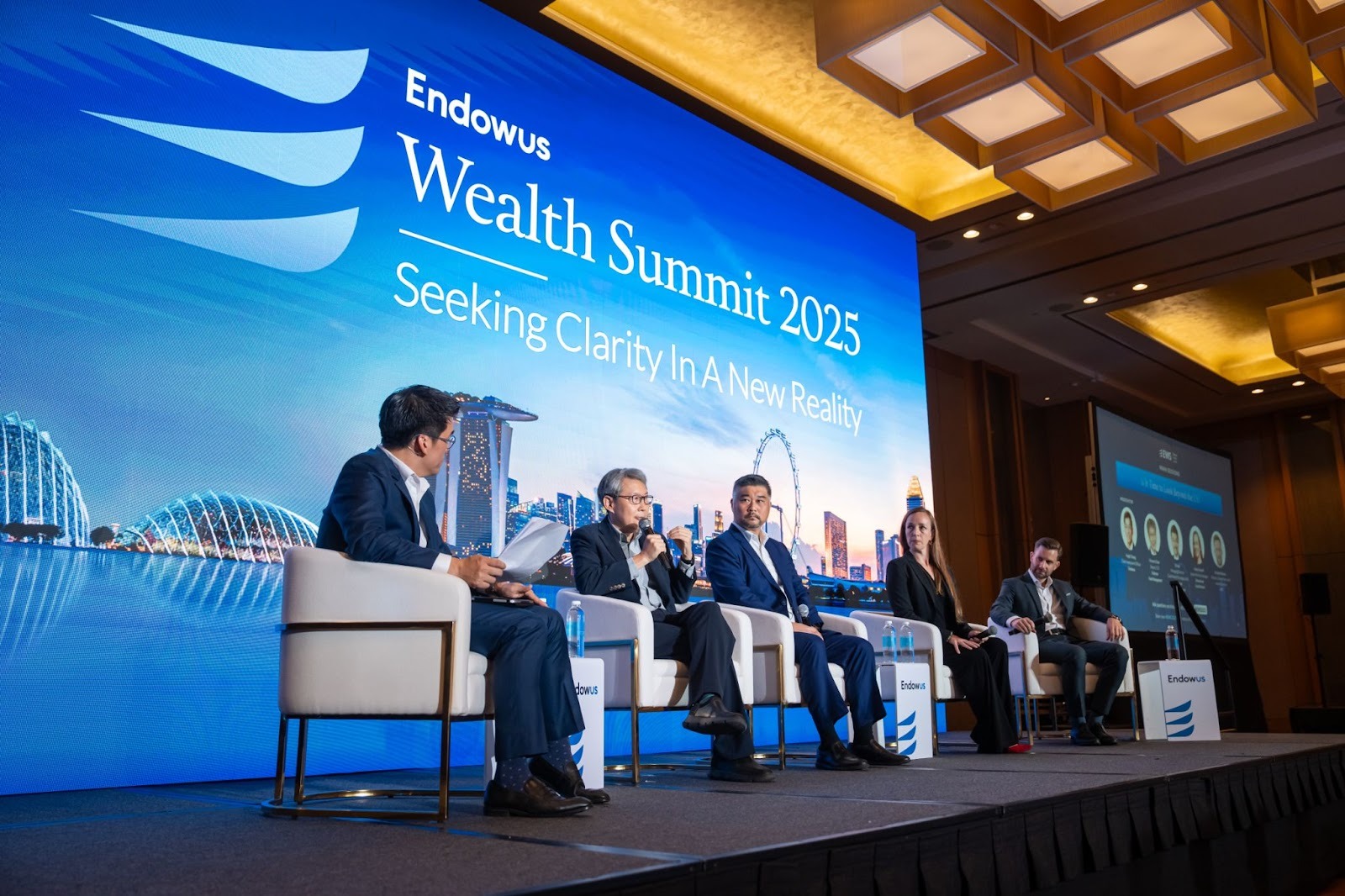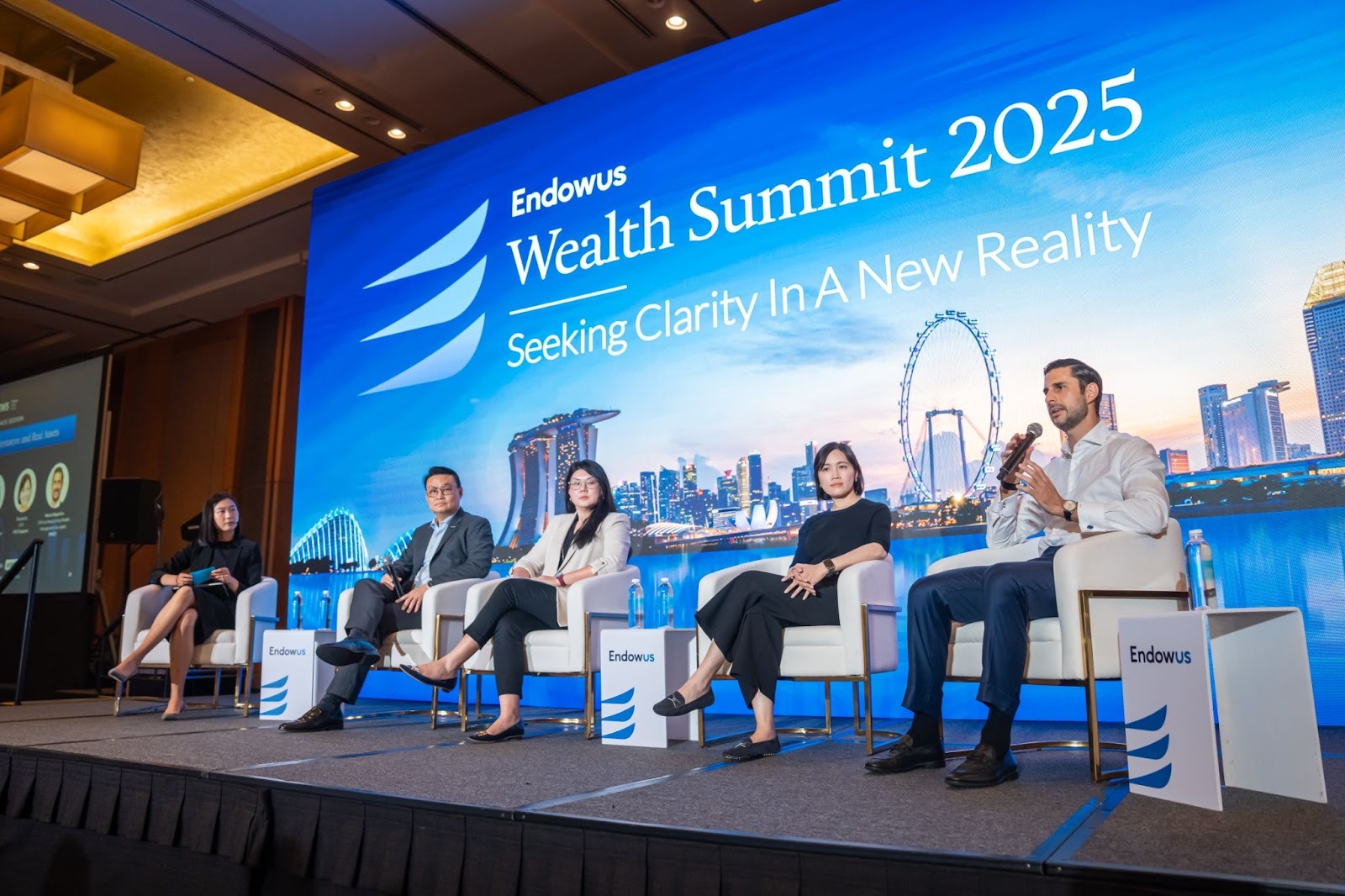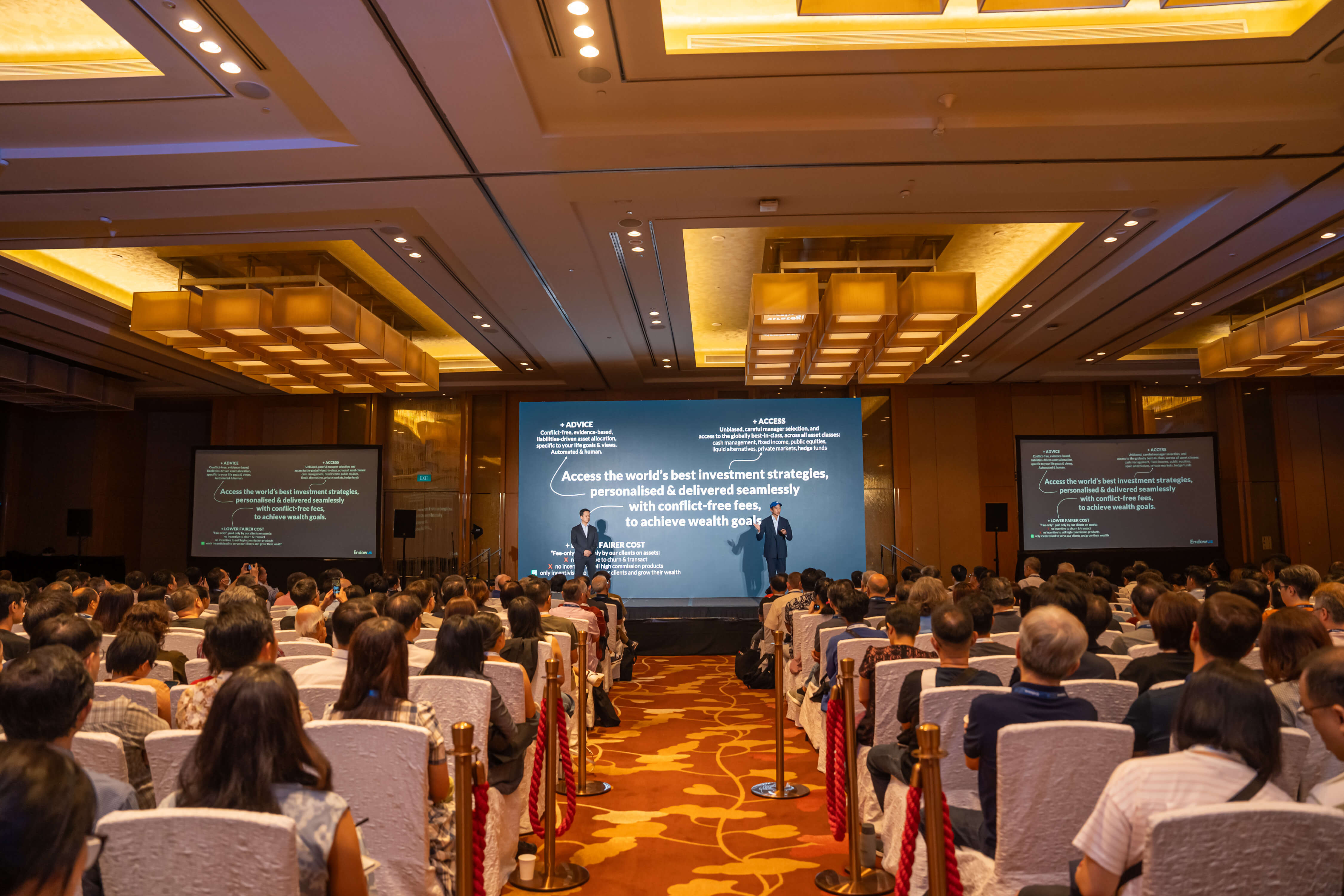Register for the event
Endowus invites you to our exclusive event with Macquarie Asset Management, as we discuss unlocking opportunities in Infrastructure- a $1.3tn asset class.
This event is reserved for Accredited Investors (AIs) only. To register for the event, please indicate one of the following:
- At our annual Summit, we want to bring the community together to hear specifically how individuals can navigate amid uncertainties and how wealth can be preserved and accumulated amid change. This year’s event theme is a call to clarity and confidence—empowering investors to steward their wealth in an era of change.
- In this article, we summarised the six panel discussions opened to all investors.
Fireside: Bracing for a new global reality

- 2025 has delivered unexpected market dynamics, with both risk assets and traditional safe havens like gold performing well. While volatility was anticipated after Trump’s re-election, the weakening of the USD—despite its status as a global safe haven—was more surprising.
- Uncertainty has eased and macroeconomic shocks have largely been avoided. Growth remains resilient, though sectoral softness and a weakening labour market signal areas to watch.
- Bubble risk remains, as US valuations approach levels last seen in 2000. The concern is whether AI capital expenditure—currently funded ahead of profitability—can sustain momentum. If funding dries up or profitability is delayed, parallels to the post-2000 tech unwind may emerge. While predicting bubbles is difficult, the risk remains real.
- Diversification remains essential, both across and within asset classes. Equities are highly correlated, and portfolios need exposure to assets that behave differently—such as bonds or private markets. Within equities, concentration risk is high, especially in US large caps. A balanced 70/30 global stock-bond portfolio continues to be hard to beat, even for sophisticated institutions.
- Private markets offer diversification but require deeper scrutiny, especially around valuation and correlation drivers. Unlike public equities, private capital isn’t marked to market, which can mask volatility. Investors must assess whether performance is driven by fundamentals or sentiment, and whether private assets truly diversify portfolio risk.
- China remains a viable but complex market—its innovation and scale rival the US, but structural challenges like housing and governance persist. There are returns to be had investing in China, but exit flexibility is key.
Is it time to look beyond the US?

- US exceptionalism is being re-evaluated as structural strains, geopolitical tensions, and shifting global growth patterns challenge its dominance. While the US still leads in innovation and market depth, marginal GDP and wealth creation are increasingly coming from Asia. Investors are reconsidering the 60–65% US weighting in global indices and exploring more balanced allocations.
- Asia offers compelling opportunities across both public and private markets, with private market penetration still nascent and ripe for value creation. Public market themes such as AI, re-globalisation, and China’s pivot to tech-driven growth are gaining traction. Investors benefit from greater control and strategic influence in private assets, especially in emerging Asian economies. Active management is key to capturing high-conviction opportunities—whether in semiconductors, governance reform, or policy-driven sectors.
- Japan, Korea, and India are undergoing meaningful reform, improving shareholder alignment and corporate governance. Japan’s shift away from cash hoarding, Korea’s earnings focus, and India’s structural scale-up present differentiated growth stories. These markets are becoming less correlated to the US and offer long-term potential.
- USD exposure is now a portfolio risk, not just a default anchor. The dollar is seen as overvalued, with potential downside ahead. Hedging is costly, but assets like gold or earnings-backed equities (e.g. AI firms) may offer natural offsets. Investors should explicitly assess their USD exposure and consider diversification strategies to mitigate currency vulnerability.
Are we early or late on AI?

- We are still early in the AI cycle, particularly in infrastructure buildout and compute capacity. Despite headline-grabbing announcements from OpenAI and Nvidia, foundational elements like LLM development and semiconductor supply (e.g. AI GPUs) are far from mature. The rollout of AI hardware will take years, and valuations—while rising—are underpinned by strategic partnerships and long-term growth potential.
- AI is reshaping how we assess business models, especially in early-stage companies. Investors are shifting focus from “AI-first” firms to those where AI acts as an enabler. Key evaluation criteria include the quality of proprietary data moats, the ability to deploy and productise technology, and management’s approach to pricing and scaling. Traditional moats still matter, and ROI must be stress-tested beyond hype.
- The real impact of AI lies in orchestration and execution, not just in the technology itself. Implementing AI is a cross-functional challenge that requires top-down support. Many companies struggle to integrate various AI tools meaningfully. Understanding the type of AI—whether generative, machine learning, or statistical—is less important than solving a real problem with cohesive deployment.
- Valuations are justified if viewed through a long-term lens, especially in private markets. While some worry about circular investment dynamics, the panel emphasized that AI’s transformative potential—across sectors like digital biology, space, and robotics—will dwarf past tech cycles. Unlike the dot-com bubble, AI is expected to fundamentally reshape business models at scale.
- Investors must cut through the noise to find true innovation, as the term “AI” now spans everything from statistical models to artificial general intelligence. The signal-to-noise ratio is high, and success depends on identifying companies with real tech and product superiority, especially in underserved verticals. Cybersecurity and AI protection are also emerging as critical investment themes.
Is it time for Singapore and SEA?

- Singapore’s equity market is regaining relevance in global portfolios, having outperformed regional peers over 1, 3, and 5 years. Despite its small index weight, Singapore offers stable political and macroeconomic conditions, strong corporate earnings—especially in financials—and a strategic role as Asia’s largest oil trading hub. Its safe-haven status and disciplined policies make it a valuable diversifier, particularly in volatile global environments.
- The Equity Market Development Programme (EQDP) is a catalyst for unlocking value, targeting small and mid-cap companies outside the STI index. With a S$5 billion injection, the initiative aims to close valuation gaps through active engagement, balance sheet optimisation, and improved visibility. Over 30 IPOs are in preparation, and SGX is expanding product offerings—including SGD-denominated access to Thai and Indonesian stocks—to broaden investor reach and deepen liquidity.
- Currency stability is a critical advantage for Singapore, especially amid rising debt concerns in developed markets. SGD’s trade-weighted management offers resilience, and in today’s macro instability, it serves as a hedge against USD volatility. For Singapore-based investors, SG equities act as a reserve asset—hedging USD exposure back to SGD can erode returns by up to 2.5%, making currency strategy essential.
- Sector diversification is strengthening beyond the traditional banking trio, with growth potential in tech (semiconductors, AI), real estate, hospitality, and financial services. Singapore’s positioning in regional tech supply chains and its appeal as a venue for high-profile events (e.g. F1, concerts) support a broader investment narrative. EQDP is expected to help unlock undervalued assets, especially in a low interest rate environment.
- Southeast Asia’s fundamentals remain strong despite recent market drift, with a growing middle class, young demographics, and rising infrastructure investment. ASEAN’s population rivals the EU’s, and intra-regional strengths—from Thailand’s hospitality to Malaysia’s semiconductor scale—offer bottom-up opportunities. Foreign holdings are at 15-year lows, and as geopolitical overhangs ease and the USD weakens, SEA markets are poised for a rebound. Private markets are vibrant but need public market revitalisation to enable exits and sustain growth.
Beyond traditional: Alternative and real assets

- Alternative and real assets are increasingly essential for portfolio diversification and inflation protection, especially as traditional equities and bonds face structural limitations. Real assets—spanning commodities, real estate, and infrastructure—offer differentiated risk-return profiles. Each subcategory carries distinct risks: gold is sensitive to interest rates and investor sentiment, real estate to local economic cycles, and infrastructure to geopolitical factors.
- Gold remains a cornerstone inflation hedge, with a 40–50% YTD appreciation driven by limited supply, rising demand from central banks and governments, and weakening confidence in the USD. The dollar’s 11% depreciation—its first since 1953—has accelerated gold’s appeal. For the first time in 30 years, global central banks now hold more gold than US Treasuries. Investors must distinguish between physical gold, gold stocks, and paper gold strategies, with a preference for fully backed instruments.
- Liquid alternatives and digital assets offer non-correlated return streams, but come with complexity and cost. Liquid alts, such as long-short strategies, require deeper analysis and expert guidance, yet can deliver outsized returns. Digital assets like stablecoins are gaining traction for cross-border payments, while Bitcoin is increasingly viewed as a store of value and innovation play. Volatility varies widely across tokens, and platforms like OKX actively screen for risk and limit exposure to speculative assets.
- Exposure to non-traditional assets should be tailored to individual circumstances, starting with a solid core of high-quality fixed income and equities. A 60/40 portfolio remains a strong foundation, with alternatives layered in based on risk tolerance and investment goals. Investors should understand how each asset behaves and complements their broader strategy—diversification is not just about adding assets, but about how they interact.
- Risk management is critical in the alternative space, from market volatility and platform risk to scams and liquidity traps. Appetite for risk is personal, and investors must be clear on what they’re exposed to. While alternatives can enhance returns and resilience, they require thoughtful implementation, ongoing education, and a clear understanding of underlying drivers—not just performance headlines.
Reimagining a better FIRE & retirement

- FIRE isn’t one-size-fits-all, especially for those in their 40s and 50s, where time to compound investments is limited. Achieving financial independence requires 15–20 years of consistent investing, and late starters may need to make trade-offs or accept more modest outcomes. The deeper question is whether early retirement is truly the goal—or if job satisfaction and purpose matter more.
- CPF remains a powerful equaliser and cornerstone for retirement planning, especially under the 1M65 framework. Topping up the Special and MediSave Accounts offers stable, compounding returns, while excess funds can be invested. However, liquidity and policy risks must be considered. Reaching Full Retirement Sum early allows CPF to compound quietly while other assets are deployed more flexibly.
- Younger generations are redefining retirement priorities, focusing less on FIRE and more on job security, financial stability, and personal well-being. Expense management and distinguishing needs from wants are critical. Lifestyle inflation and comparison culture often derail long-term goals. Living well within one’s means and aligning financial plans with life values are key to sustainable adequacy.
- FIRE misconceptions persist—especially around how much is “enough”, which depends on lifestyle expectations and cost structures. Entrepreneurs and those with less CPF compounding time must rely on more liquid and diversified assets—housing, treasury instruments, stablecoins, indices, and even Bitcoin. Health is also a strategic investment, helping avoid future financial strain and supporting intergenerational resilience.
- Balancing CPF and equities can offer the best of both worlds, with CPF providing slow but steady growth and equities offering higher upside with volatility. A split-pot approach allows for stability and growth. However, topping up CPF later in life may be less effective due to shorter compounding windows. Retirement planning should be tailored to individual risk appetite, liquidity needs, and long-term goals.










.webp)




%20(1).gif)


.png)
.jpg)


%20F1(2).webp)

.webp)






.webp)